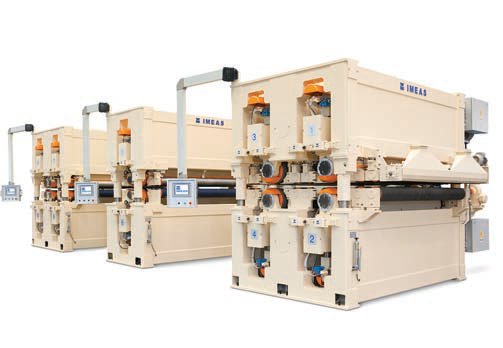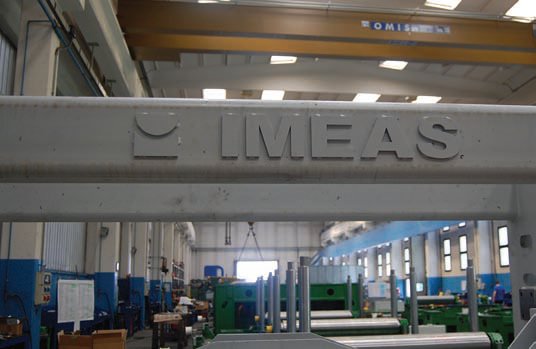Calibrating the finish
1 September 2015Sanding technology manufacturer Imeas has a long history in sanding panels and in grinding stainless steel, for instance for continous press belts. Stephen Powney dropped into its Villa Cortese factory near Milan to see the latest innovations.
Created in 1966, sanding machinery manufacturer Imeas SpA's customer reference list is like a who's who of the wood based panel industry - Uniboard, Masisa,
Glunz, Finsa and Egger being among those sourcing their wide-belt sander requirements for panel making projects.
Imeas, which also has a production subsidiary in China, has an annual turnover of €20m and employs more than 200 people globally.
It provides solutions from calibrating to sanding, to ultra-finishing and cross-sanding, with working speeds up to 150m/min and solutions for non-stop 24-hour working.
Its Modula range of calibration and sanding machines for MDF, particleboard and plywood production feature working widths up to 3.8m.
The Combi range is engineered for calibrating and fine sanding, while the CR-TB CrossSander (speed of 70m/min) is aimed at HDF/MDF and particleboard, which will then be varnished, painted or coated with light melamine papers.
During our visit to the Villa Cortese factory in June, the company had interior designers in the office building, as it was planning to redesign its green meeting room.
"Ligna was a very successful exhibition," said Imeas' sales director, and son of the founder, Francesco Zenere. "We were busy all the days and had discussions on real projects, not just to say 'hello' and share a drink and see you again in two years' time. It was better than two years ago."
Solutions which Imeas was showing to customers at Ligna include the Full Control System (FCS) and Full Control Belt system (FCB).
The FCS management software offers graphical visualisation, with precision positioning of each sanding head. Imeas says its remote management capabilities, together with the process optimisation of FCS, allows customers to reduce their direct sanding operating costs by up to 15%.
There is also data exchange with ERP systems; and thickness measurement devices for automatic set-up of operating parameters from the control room.
For flexibility, the use of open standards allows for a tailor-made configuration of the system, warnings, working recipes and sanding policies. The remote management includes set-up for product change and actual working parameters.
FCB is designed to give accurate positioning of the sanding belt on the drums by use of photocells which give continuous measurement of the position of the belt. The system automatically adjusts the belt from side to side to return to its central position.
During our last visit to Imeas, the company was working with a partner to integrate a measuring system into its machines, with the thickness measured before and after sanding, with each sanding head being adjusted in a closed loop.
"There is interest in the market in integrating measuring systems into the machine," said Mr Zenere. "There is technical interest in doing this but customers do not have the budget to try this at the moment," he said.
Imeas's improvement packages for existing installations have been working well. "There are more and more customers asking for retrofitting of machines," said Mr Zenere.
One example is the Italian particleboard producer Frati. Imeas retro-fitted a 34-year-old Imeas sander which Frati had bought in 1978, giving many improvements such as machine adjustability and better feed speeds.
Mr Zenere reported that Italian panel sector interest in investment was recovering quite well, thanks in part to a recovering economy; Imeas is in talks about improving other lines at Frati, as well as replacing a very old line.
Another project, this time in the lively market of Thailand, saw Imeas update a unit with FCB. The company had bought the unit from Imeas about seven years ago. In this case, the company also ordered a new line.
Also in Thailand, Imeas is going to install a new line (its second) at Green River Panels.
However, China was reported as being very quiet. The company has negotiated some contracts but is waiting for final approval. Mr Zenere said a big round of investment led by the Olympics had come to an end and the economy was slowing.
"We hope the next few years will be a good market for us. The most active areas are Turkey and Thailand. There is very little activity in other parts of the world."
He said Africa was still at a very early stage in terms of panel industry developments, but he reported some bidding going on, with projects, including MDF and particleboard, in West Africa.
He reported three or four projects in Brazil, but said the economy was slowing down quite a bit. The north of Brazil, he added, was a potential region for future expansion of wood based panel production. Central American countries, such as Colombia and Peru were reportedly on hold.
Meanwhile, in North America Imeas has carried out a retro-fit project, including the FCB, with a vibration sensor to monitor the health of bearings so they can forecast when they will fail.
In Europe, Imeas is in talks with a Finnish plywood company about sanding its panels.

